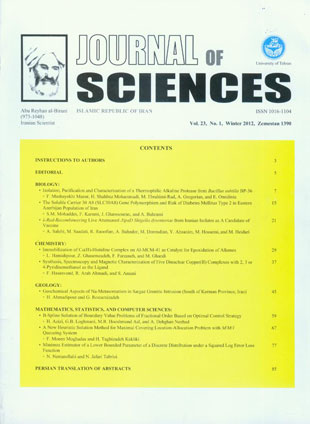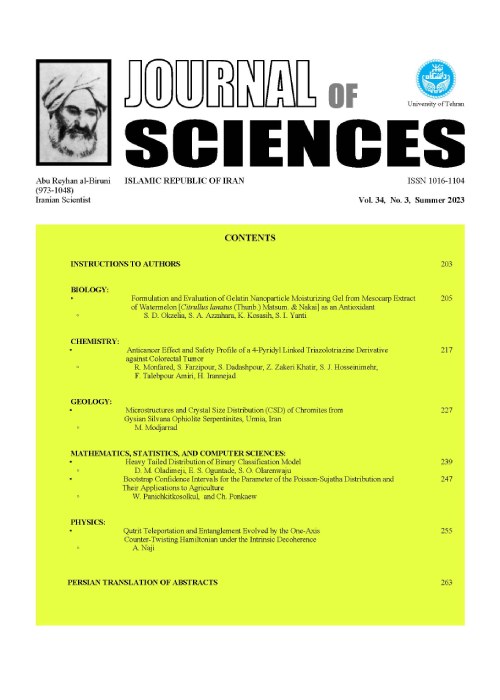فهرست مطالب

Journal of Sciences, Islamic Republic of Iran
Volume:23 Issue: 1, Winter2012
- 98 صفحه،
- تاریخ انتشار: 1391/03/25
- تعداد عناوین: 9
-
-
Page 7The goal of this research was to isolate and identify the thermostable alkaline protease producing bacteria among several native Iranian microorganisms. At the end of screening program, a Bacillus subtilis BP-36 strain producing thermophilic alkaline protease was isolated from a hot spring in Ardebil province. The target enzyme was purified using a one-step Aqueous two-phase systems (ATPS) protocol involving 22% (w/w) polyethylene glycol (PEG)-10,000, and 18% (w/w) citrate with a yield of 39.7%, specific activity of 2600 U/mg and purification factor of 4.8. It was shown to have a molecular weight of 40 kDa by sodium dodecyl sulfate polyacrylamide gel electrophoresis (SDS-PAGE). The purified thermophile enzyme was stable in alkaline pH range (9.0-11.0) with the optimum pH of 9.0. It was highly stable at 60 °C and retained 100% activity even after 90 minutes, suggesting that it belong to the family of thermophilous. Collectively, our obtained data revealed that the thermophilic protease produced by B. subtilis BP-36 has the potential application in industrial processes under high temperature.Keywords: Alkaline protease, Bacillus subtilis, Isolation, Purification, Thermophilic
-
Page 15Type 2 Diabetes Mellitus (T2D) is the most common metabolic disease demonstrating itself by hyper- glycemia, due to impaired insulin secretion or action. Recently, Whole-Genome Association studies have revealed the role of several new genes responsible for T2D. One of the most studied genes is SLC30A8 (Zn-T8) which is exclusively expressed in pancreatic β-cells and participates in insulin storage and transfer. A number of previous studies support the role of R325W (rs13266634) variant of this gene in T2D risk. The present study was designed to determine the possible association of rs13266634 polymorphism of SLC30A8 gene with T2D in the population of Eastern Azerbaijan province. We genotyped the rs13266634 polymorphism in Azeri samples, using 250 samples prepared from T2D case and control individuals in equal numbers. Genotyping were performed using Polymerase Chain Reaction and Restriction Fragment Length Polymorphism assay (PCR-RFLP). No significant association was detected between rs13266634 variant of SLC30A8 gene and T2D in our study population (p>0.05). Moreover, none of the metabolic and anthropometric parameters had significant differences for RW (heterozygote mutant) and RR (homozygote mutant) genotypes in case and control groups (p>0.05). Significant differences was observed in fasting blood sugar (FBS), glucose tolerance test (GTT), age, education and economic status between case and control groups (p<0.05), while the differences in BMI and gender between the two study groups were non-significant.Keywords: T2D, SLC30A8, Polymorphism
-
Page 21Shigella species (spp.) are gram-negative bacteria that are responsible for shigellosis. Although it can be controlled via antibiotics, increasing number of antibiotic resistant isolates of Shigella have been reported. Therefore, other strategies such as production of specific vaccine against this organism could be a suitable therapeutic approach. Attenuated live vaccines produced by gene deletion are advised candidates of vaccine against shigella. The ipaD gene is responsible for Shigella invasion which act as a chaperone for some other invasion proteins such as IpaB and IpaC. We used λ-red recombination system to delete the ipaD gene in shigella that end to production of a live attenuated form of Shigella dysenteriae. This strain has a high prevalence in Iran that make it suitable target for vaccine production. Our results showed that live attenuated ΔipaD Shigella was produced via λ-red recombination system. We suggest that application of λ-red recombination could be a simple and useful technique for production of live attenuated ΔipaD Shigella as a candidate of vaccine against shigellosisKeywords: Gene deletion, Shigella dysenteriae, λ, red Recombination, ipaD, Attenuated live vaccine
-
Page 29Cu(II) complex with L-histidine (His) ligand, immobilized within Al-MCM-41, designated as Cu(His)2/Al-MCM-41 was prepared and characterized by powder X-ray diffraction (XRD), nitrogen adsorption desorption, FTIR, UV-Vis and chemical analysis techniques. The surface area and pore volume were found to decrease after immobilization of Cu(II) complex on Al-MCM-41. It was found that Cu(His)2/Al-MCM-41 catalyze the oxidation of some alkenes such as norbornene and trans-stilbene with tert-butylhydroperoxide (TBHP) with high activity and selectivity to the corresponding epoxides. It was concluded that the Al-MCM-41 nanoreactors is a suitable support for immobilization of biomimetic molecules. Particularly significant is that no desorption was observed during the course of reactions.Keywords: Al, MCM, 41
-
Page 37The synthesis, spectroscopy and magnetic characterization of five new dinuclear copper(II) complexes are described. All five compounds have the general formula [Cu2(L)4(O-R)2](Cl)2 or [Cu2(L)2(Cl)2](Cl)2, in which R = CH3 or H, L=2, 3 or 4-pyridinemethanol as L2, L3 or L4, respectively. The title compounds consist of dinuclear units with bridging methoxo groups in [Cu2(L4)4(O-CH3)2](Cl)2, hydroxo groups in [Cu2(L4)4(OH)2](Cl)2, and bridging chloro moeities in [Cu2(L4)4(Cl)2](Cl)2, [Cu2(L3)4(Cl)2](Cl)2 and [Cu2(L2)4(Cl)2] (Cl)2. Each dinuclear unit consisting of two ligands linked to each copper via the pyridine N atom, providing a Cu2N2A2 unit (where A = OH, O-CH3 or Cl). All complexes have been synthesized in a one-step reaction and characterized by elemental analysis, Fourier transform infrared (FTIR), electron spin resonance (ESR), and electronic spectra and by room temperature magnetic moments. The compounds exhibit antiferromagnetic interaction at room temperature. The UV-Vis spectra show three absorptions attributed to the d-d transition of the copper (II) ion, ligand→metal charge transfer and π→π* or n→π* transitions of the ligand. The FTIR spectra indicate a Cu2N2A2 ring vibrating from 395 to 530 cm-1. All complexes show a room temperature magnetic moment between 1.55 and 1.67 B.M. per copper atom. The X-band electron spin resonance (ESR) spectra of samples in DMF or DMSO frozen at liquid nitrogen temperature show a typical Δm = 1 transition.Keywords: Spin, spin coupling, Dinuclear, Copper (II) complexes
-
Geochemical Aspects of Na-Metasomatism in Sargaz Granitic Intrusion (South of Kerman Province, Iran)Page 45The Sargaz granitic intrusion has been emplaced in Sargaz ophiolitic suite, south-east of Sanandaj-Sirjan metamorphic zone, south of Kerman province. The central part of the intrusive body contains pinkish coarse-grained granite, but the fractured northern part, neighboring Chah-Mazraeh fault, has been subjected to pervasive Na-metasomatism and related subsolidus reactions. In the northern altered rocks, the primary magmatic textures have been changed into a new generation of albite along with chlorite, epidote and sericite. Petrographically, in Sargaz altered rocks, albite occurs as overgrowth, crack-filling, vug-filling and interstitial forms. The first form has been replaced the primary plagioclase, and/or alkali feldspars by a coupled dissolution-reprecipitation mechanism, while, the other forms have been crystallized from Na-rich alkali fluids during Na-metasomatism. In Sargaz unaltered granites, primary feldspars contain oligoclase (An23.8-An10.6) and K-feldspar (kf70-kf95.9), while, metasomatic feldspars are entirely albite (An8.4-An0.3) without any chemical zonation. Na-metasomatism in these rocks resulted obvious mass changes in rock composition, as the altered rock are enriched in Na, La, Y, Yb, Hf and Th and depleted in K, Fe, Mg, Ca, Sr, Co and Zn. Si, P, Rb, Ti, Al and Zr possibly acted as immobile elements during Na-metasomatism. Evidences in Sargaz intrusion show that alkali Na-rich fluids caused Na-metasomatism as dissolution of primary quartz and then, crystallization of albite. Microcracks facilitated infiltration of fluids. During the metasomatism, enough quartz grains were dissolved, thereby releasing silica for the formation of different forms of new albites, thus, the role of quartz dissolution, is more important than those expected earlier.
-
Page 59
In this paper, boundary value problems of fractional order are converted into an optimal control problems. Then an approximate solution is constructed from translations and dilations of a B-spline function such that the exact boundary conditions are satisfied. The fractional differential operators are taken in the Riemann-Liouville and Caputo sense. Several example are given and the optimal errors are obtained for the sake of comparison. The obtained results are shown that the technique introduced here is accurate and easy to apply.
Keywords: B, spline functions, Fractional derivative, Fractional integral, Optimal control problem, Boundary value problems of fractional order -
Page 67We consider the queueing maximal covering location-allocation problem (QM-CLAP) with an M/M/1 queueing system. We propose a new solution procedure based on decomposition of the problem into smaller sub-problems. We solve the resulting sub-problems both with a branch and bound algorithm and with the meta-heuristic GRASP. We also solve the entire model with GRASP. Computational results for these approaches are compared with the solutions obtained by CPLEX. Results show that using the new procedure in which sub-problems were solved with Branch and bound is better.Keywords: Maximal covering location problems, M, M, 1 queueing system, Heuristics, GRASP
-
Page 77The problem of estimating the parameter θ, when it is restricted to an interval of the form, in a class of discrete distributions, including Binomial Negative Binomial discrete Weibull and etc., is considered. We give necessary and sufficient conditions for which the Bayes estimator of with respect to a two points boundary supported prior is minimax under squared log error loss function. For some of the distributions in this class, we give numerical values of the smallest values of for which the corresponding Bayes estimator of is minimax.Keywords: Bayes estimator, Bounded parameter space, Discrete distribution, Minimax estimation, Squared log error loss function


